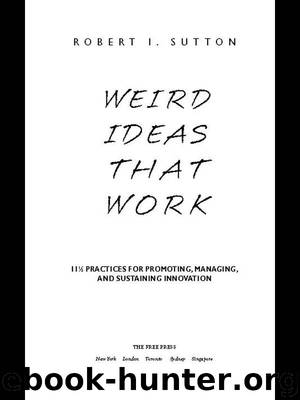Weird Ideas That Work: 11 12 Practices for Promoting, Managing, and Sustaining Innovation by Sutton Robert I

Author:Sutton, Robert I. [Sutton, Robert I.]
Language: eng
Format: epub
Publisher: Free Press
Published: 2002-03-02T00:00:00+00:00
Making Clear What Ought to Be Done
This method can be used to make explicit what the company should be doing, or at least what people believe it should be doing. By listing ideas that people believe are wrong or misguided, and then reversing them, people follow a different cognitive path than usual to reveal beliefs, theories,and evidence about what the company ought to do. This different point of view can help crystallize widespread and shared beliefs that have never been articulated before, and in doing so, people may notice gaps between what they believe is right and what they actually do. This is why Justin Kitch used this technique during the “Barney brainstorm.” He thought that by listing all the features of the least desirable product possible, and then reversing them, a more complete and powerful set of design principles could be developed than if he had just used the more common practice of asking brainstormers to generate good ideas.
I use a similar method in my consulting work. I was working with a newly formed professional services firm a few years ago. To help them think about the kind of company they wanted to be, we developed a list of what they believed were the worst characteristics of several key competitors. These undesirable—but common—attributes included selling clients only PowerPoint presentations instead of helping them implement ideas, relying primarily on young and inexperienced consultants to do most of the work, requiring long hours and excessive travel, and developing a “star system” where a tiny percentage of the consultants reaped the lion’s share of the profits. This exercise helped them realize that their own company was already using some of these same practices (especially excessive travel and long hours) and that some practices they were about to discard were important to their success (e.g., they used a pay system that did not breed superstars). A senior manager commented that this exercise made them realize that their success resulted from being different from their competitors, and that they were—unwittingly—on the verge of implementing practices that would make them just like their competitors. They decided that they needed to focus on enhancing, not narrowing, these differences.
You can take this weird idea a step further and convince people to try the dumb ideas for a while. This is similar to what some writing teachers do to help their students distinguish between weak and strong writing styles, and to improve their prose. John Vorhaus has taught writing in 17 countries, to everyone from novelists to scriptwriters for television sitcoms.13 He instructs students to write badly, for example, to “ write a run-on sentence, and the plan is simply to put off the period as long as possible. ”14 He also asks them to“write nonsense,”“wallow in lame analogies,”and to“be repetitious.”15 Vorhaus says that such “stretching exercises” teach people to write better prose because it helps them learn the difference between good and bad writing, and teaches them they can learn more from doing bad writing than no writing at all.
Download
This site does not store any files on its server. We only index and link to content provided by other sites. Please contact the content providers to delete copyright contents if any and email us, we'll remove relevant links or contents immediately.
Bad Blood by John Carreyrou(6583)
Rich Dad Poor Dad by Robert T. Kiyosaki(6513)
Principles: Life and Work by Ray Dalio(6296)
Playing to Win_ How Strategy Really Works by A.G. Lafley & Roger L. Martin(6083)
Management Strategies for the Cloud Revolution: How Cloud Computing Is Transforming Business and Why You Can't Afford to Be Left Behind by Charles Babcock(4546)
The Confidence Code by Katty Kay(4220)
Thinking in Bets by Annie Duke(4185)
American Kingpin by Nick Bilton(3819)
Delivering Happiness by Tony Hsieh(3395)
Project Animal Farm: An Accidental Journey into the Secret World of Farming and the Truth About Our Food by Sonia Faruqi(3189)
The Power of Habit by Charles Duhigg(3094)
The Tyranny of Metrics by Jerry Z. Muller(3028)
Brotopia by Emily Chang(3026)
Mastering Bitcoin: Programming the Open Blockchain by Andreas M. Antonopoulos(3011)
The Marketing Plan Handbook: Develop Big-Picture Marketing Plans for Pennies on the Dollar by Robert W. Bly(3006)
I Live in the Future & Here's How It Works by Nick Bilton(2960)
The Content Trap by Bharat Anand(2887)
Applied Empathy by Michael Ventura(2864)
Building a StoryBrand by Donald Miller(2862)
